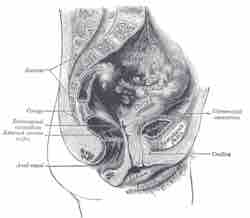The Urethra
The urethra is a tube that connects the urinary bladder to the genitals for the removal of fluids from the body. The external urethral sphincter is a striated muscle that allows voluntary control over urination by controlling the flow of urine from the bladder into the urethra.
The Female Urethra
In females, the urethra is shorter relative to males, and emerges above the vaginal opening. Its lining is composed primarily of non-keratinized stratified squamous epithelium that becomes transitional near the bladder. The urethra consists of three layers of tissues:
- The muscular layer is a continuation of the smooth muscle of the bladder.
- The erectile urethral tissue is specialized tissue that may become engorged with blood during sexual arousal.
- The mucuous urethral tissue are mucous membranes that line the interior of the urethra. The mucuous membranes are especially important for protecting the urethral tissues from the corrosive effects of urine.
The urethral sphincter separates the bladder from the urethra. Somatic (conscious) innervation of the external urethral sphincter is supplied by the pudendal nerve, which allows the sphincter to open and close. As the urethra is shorter in females relative to males, they are more vulnerable to bacterial urinary tract infections.

Female urethra
A depiction of a female urethra.
The Male Urethra
In males, the urethra travels through the penis and carries semen as well as urine. Semen does not flow through the bladder or the rest of the urinary tract, instead it is a fluid made of sperm cells and other fluids that passes through a few different glands from the testes to the urethra through the vas deferens. Aside from semen, and the male urethra's greater length, it is structurally similar to the female urethra.

Male urethra
A detailed view of the male urethra.